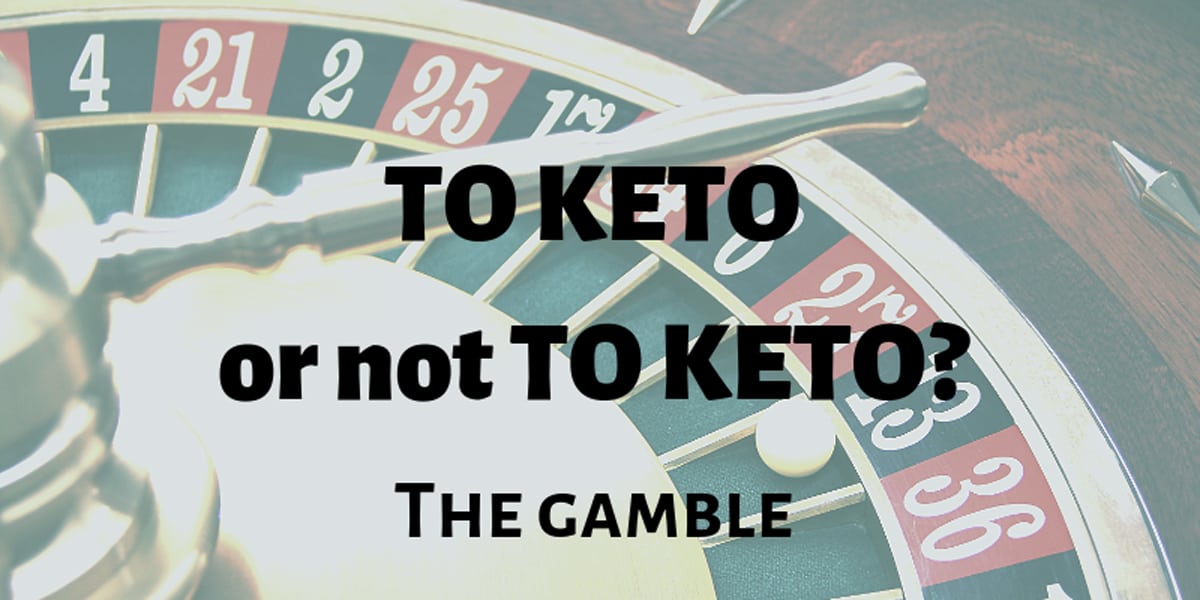To keto or not to keto? This is a question frequently asked by people who are primarily looking to lose weight, and sometimes by those looking to improve their general health.
There has been a growing trend of this type of diet - with keto being a weight loss "buzz word" - and there are many influencers on social media promoting the benefits of following such a diet, backed up by the clear evidence of substantial weight loss results. So, what is the principle behind the ketogenic diet and does it really work?
Before embarking on any strict dietary regime, it is important to understand the rationale and therefore the aim of this article to explain this particular dietary approach, the content of which has been taken from the Plaskett Weight Management Consultancy Diploma.
The Principle of the Ketogenic Diet
We first need to describe the main principles and outline the basis upon which the ketogenic diet works.
Firstly this approach does not aim to reduce calorie intake at all. Instead it presents the body with nutrients in such a way that a high proportion of the calories in the dietary fat will not be utilized. In fact, it aims to ensure that much of the energy in the ingested fat will be excreted through the urine and therefore wasted. The diet is popular because:
- It works and
- It leaves the person the freedom to eat quite a lot if he or she wants to, especially fatty foods like meat and cheese and because frying and other forms of cooking in oil are permitted.
It sounds almost like magic in that the “deprivation” aspect of dieting is removed. It sounds like an easy route to success. Yet there is a deprivation aspect because you must not have much carbohydrate. Some people claim that the ketogenic diet itself produces some inhibition of appetite, but that has not been clearly demonstrated. If the diet produces nausea (which it easily could) lack of appetite would be a result for some people.
What is the Ketogenic Diet?
This type of diet allows the person to eat quite large amounts of fat‐rich, protein‐rich foods but it bars eating any of the carbohydrate‐rich foods. Hence, grains and flours, flour products and potatoes are excluded. This cuts out bread, cakes, breakfast cereals, pastry, pasta, chips, roast potatoes and all bakery goods. It cuts out sugar, rice, potatoes, pulses, high‐carbohydrate fruits like banana, and special carbohydrate foods like sago or tapioca.
This leaves the dieter to have plenty of meats, fish, eggs and dairy products from which the sugar element (lactose sugar) has been removed. These dairy products essentially comprise cream, butter and cheese. Vegetable oils may be taken but not the oilseeds from which they come because these contain too much carbohydrate. Some people will find this sort of very high fat diet very unattractive and, of course, it is virtually impossible for vegetarians or vegans. Although most meats and fish are included in the diet there must be no meat pies (due to the pastry), sausages (due to the rusk), faggots, fishcakes (due to the potato) or other composite products that would contain a carbohydrate element.
It is usual for the diet to include some element of fruit or vegetable. However, there is a risk of invalidating the main principle of the diet through their use over and above a very modest intake (see below).
As soon as the client deviates from this precisely defined path by taking carbohydrate, the principle of the diet is invalidated and it will no longer work. The essential feature of this diet is that it is, to all intents and purposes, a carbohydrate‐free diet. This type of diet is often called the Atkins diet, after its promoter, Robert Atkins (1992).



Why the Ketogenic Diet Works
The principle behind the ketogenic diet is that the normal breakdown of fat to carbon dioxide and water, yielding energy, requires that a certain amount of carbohydrate is being broken down at the same time. This fact is often embodied in the saying that “fats burns in the flame of carbohydrate”.
At any given time the body itself contains rather little carbohydrate. If we do without food (fast) for 24 hours, our carbohydrate reserves (glycogen) in the liver will be just about used up. Most of the rest of the organic material in the body is composed of lipid (fatty substances) and protein. We therefore have little carbohydrate left to metabolise and we are in a carbohydrate‐deficient state.
The breakdown of fatty acids (the main components of fat) occurs in two stages. The first stage (called beta‐oxidation) yields only a little energy for the body to use and does not depend upon carbohydrate being present. This stage therefore takes place readily enough even though carbohydrate is almost absent. This stage results in the production of intermediate compounds called “ketone bodies”. These intermediate substances can not only be formed, but can accumulate, in the virtual absence of carbohydrate. When carbohydrate is present they do not accumulate because their further breakdown goes ahead. When carbohydrate is virtually absent, however, the second stage of breakdown, called the “Krebs Cycle”, cannot go ahead. Hence, the ketone bodies accumulate in the tissues and blood and they soon start to be excreted in the urine. This condition is known as “ketosis”.
These ketone bodies still contain most of the energy of the original fat. Obviously, then, as they are excreted in the urine, this energy is lost. These ketone bodies, therefore, represent energy that might otherwise (had carbohydrate been present) have been stored as surplus fat in the fat depots of the body. Hence their loss from the body is a triumph so far as weight reduction is concerned. These are calories that are being lost without the need to either restrict food or to do major exercise.
This is why the diet works! The calories from ingested fat are being excreted rather than being “burned” in the oxidation pathways of the body. The body derives no energy from these “lost” ketone bodies and is not left with fat that has to be stored in the fat depots. The person has the satisfaction of being able to eat calories as fat, most of which are then passed out from the body without being used.
Meanwhile the body cannot do without maintaining the blood sugar level. This is achieved in part through the very small amount of carbohydrate that still “gets through” in the dietary intake plus that derived from the breakdown of proteins. The person doing this diet has the satisfaction of the above situation and the results. However, he or she must nonetheless eat a very high‐fat diet that may sometimes be nauseating and must safeguard very strictly against consuming enough carbohydrate to negate the effect of the special principle that makes this diet work.
The amount of carbohydrate intake that can begin to invalidate the principle of this diet is extremely small.
How Much Carbohydrate Invalidates the Ketogenic Diet?
According to Atkins, humans today vary significantly in the level of carbohydrate deprivation that will induce ketosis. Those with a high metabolic resistance to ketosis may need to go as low as 15g of carbohydrate intake per day to induce any ketosis. Those with low metabolic resistance may induce ketosis even at 40‐60g per day. Nonetheless, even when there is ketosis at, say, a 50g/day carbohydrate intake, one should remember that there will be less ketosis at this level of carbohydrate than there would be at a lower intake. Hence, the weight loss resulting from this diet will be less significant as the carbohydrate intake rises to 50g.
Moreover as time goes on, with the system in ketosis, the cells throughout the body become more efficient at breaking down ketone bodies through the Krebs cycle. This improvement is apparently achieved through the induction of more enzymes. The short supply of Krebs cycle intermediates is unlikely to be overcome but we can suppose that the available levels of these are turned over more rapidly. This will reduce the ketosis and therefore the acidosis. It will also reduce the effectiveness of the Atkins diet as a weight‐ loss procedure after the passage of time.
It is the severe stricture that must be applied to carbohydrate intake that limits the use of fruit and vegetables. For example, a single pear of around 200g contains about 30g of carbohydrate (Holland et al 1991). This is enough to invalidate the principle of the diet in some cases. In other people there will be ketosis, but less of it, and less weight loss will occur than would be the case on a lower carbohydrate regime. A portion of 300grams of carrots may contain from 20‐24g of carbohydrate and hence is slightly less likely to disrupt the diet. However, anyone who wants to have a reasonable amount of plant matter in this type of diet had better go for those individual vegetables with carbohydrate levels below 2% of fresh weight, such as asparagus, broccoli, celery, courgette, cucumber, kale, fennel, lettuce, mushrooms, mustard and cress, radish, watercress or spinach. If as much as 500g of these vegetables are included they will only deliver about 10g of carbohydrate. Possibly as much as 750g/day of these very low carbohydrate items might be allowed, giving 15g/day of carbohydrate intake. This will be the best way to eat vegetables whilst still retaining the ketogenic character of the diet. If one allows the carbohydrate element of the vegetable to rise to 3% of fresh weight then this brings in leeks, cauliflower, marrow, pumpkin, spring greens, spring onions, green capsicum and tomato. An allowance of 500g/day of these will deliver 15g/day of carbohydrate. Raising the stakes still higher, if one allows 4% of carbohydrate in the vegetable this brings in Cabbage and Brussels sprouts, 500g of which would make up to 20g of carbohydrate/day. Obviously one may make up useful mixtures of these vegetables having different carbohydrate content that would restrict the daily carbohydrate from vegetables to 15g/day. One should perhaps not go above this level when the objective is weight loss because one must take into account traces that come in from other dietary items.
The range of suitable fruit is far more restricted: avocado (1.9), gooseberries (3.0), olives (trace only), galia melon (3.8) and rhubarb, which is not really a fruit but gets used as though it were (0.8), are the only good choices.
Choice among fruits and vegetables is obviously very important, especially as the carbohydrate content of vegetables may go very high, for example sweet potato (21%) and grapes (15%).

Nutritional Disadvantages of the Ketogenic Diet?
This diet has, in all its variations, a marked imbalance of macronutrients that may, according to much of the literature, predispose in the long run to a myriad of chronic ailments. This may not need to worry someone who wants to use the ketogenic diet for a 3‐month slimming period but it would give rise to concern about longer‐term use. Such diets tend to be low in vitamin C. Enhanced calcium loss can also occur due to the high protein intake. The high uric acid produced from the protein foods may be dangerous for those predisposed to gout. These diets have high cholesterol content, dangerous for people with high blood cholesterol (hypercholesterolaemia). They often cause nausea, hypotension, and fatigue. There is obviously a strong case to be made for micronutrient supplementation when such diets are used. This need for supplements is likely to be the greatest when vegetables or fruits are not being used.
Health Problems Associated with Ketosis
The disadvantages of ketosis result primarily from the acidosis (excess of tissue acid) that accompanies it. Two of the ketone bodies, namely acetoacetic acid, and beta‐ hydroxybutyric acid, are organic acids. Hence they tend to acidify the body fluids in proportion to their concentrations. The acidosis caused by the ketosis can be dangerous (Groff et al 1995). The principal effects of the acidosis associated with ketosis are known to affect respiration, gaseous exchange, the heart, nervous system and bone, and to exert multiple adverse systemic actions on metabolism generally (4). These are set out in the following Table below.
Adverse Effects of Metabolic Acidosis that Ketosis may Cause
Respiratory effects |
Causes “deep sighing respiration”. |
Inhibits sugar breakdown |
This is due to an effect upon an enzyme, which is rate-limiting for sugar breakdown. However, this might well aggravate the effect of limited carbohydrate supply by slowing the metabolism of whatever sugars are available. |
Effects on oxygen delivery |
Acidity alters the interaction between oxygen and haemoglobin– hence it brings about impairment of oxygen uptake in the lungs. |
Effects on the nervous system |
Severe acidosis can cause various degrees of impairment of consciousness. This varies from mild drowsiness to coma. |
Kidney effects and effects on protein. |
The kidney produces additional ammonia to offset the acidity. This is linked to an increase in the breakdown of proteins for the supply of blood glucose. Hence there is more wastage of protein and the person with acidosis is more prone than normal to negative nitrogen balance. |
Bone effects |
Acidosis leads to leaching of bone mineral and hence to negative calcium balance. |
Obviously then, as with any restrictive diet, the ketogenic diet should not be used without first balancing the dangers and the advantages. You should, in most cases, avoid using the ketogenic diet if other measures will work, so as to avoid the associated risks. To make a positive decision to use the ketogenic diet, the risks of not using it should outweigh the risks of doing so. In general, therefore, the ketogenic diet will be applied to very obese people who have failed to reduce their weight in other ways.
It is important to note here that there is case for the ketogenic diet to be used in cancer therapy however this is beyond the realms of this article and should be covered separately.
The content of this article has been taken from our Weight Management Consultancy Course.
References
Atkins, R.C., 1992; “Dr. Atkins’ New Diet Revolution”, Avon Books, New York.
Groff, J.L., Gropper, S.S., & Hunt, S.M. 1995; “Advanced Nutrition and Human Metabolism”, West Publishing Company, USA, p138.
Food Standards Agency (2002), “McCance & Widdowson’s The Composition of Foods” 6th Summary Edition, Cambridge, The Royal Society of Chemistry.
Holland, B., Welch, A.A., Unwin, I.D., Buss, D.H., Paul, A.A., and Southgate, D.A.T., 1991), “McCance & Widdowson’s The Composition of Foods” 5th Edition, Royal Society of Chemistry and Ministry of Agriculture Fisheries and Food.
Ledingham, J.G.G. & Warrell, .A., Eds. 2000; “Concise Oxford Textbook of Medicine”, Oxford University Press.
Pennington, J.A.T., (1994), “Bowes & Church’s Food Values of Portions Commonly Used”, 16th Edition, J.B. Lippincott Co., Philadelphia, Pennsylvania, USA.
Plaskett, L.G. 2002; “On the Essentiality of Dietary Carbohydrate”, paper given to the British Society for Allergy and Environmental Medicine, London, Nov 1st and later submitted to the Journal of Nutritional & Environmental Medicine.
Wilmore, J.H. & Costill, D.L., (1994), “Physiology of Sport and Exercise”, Human Kinetics.

